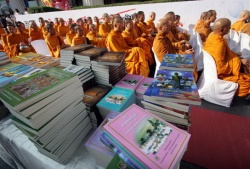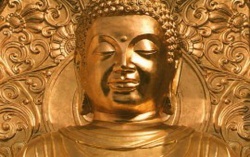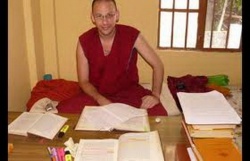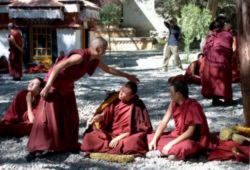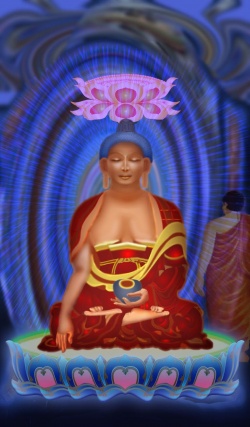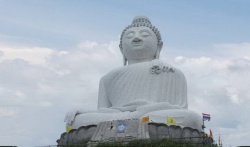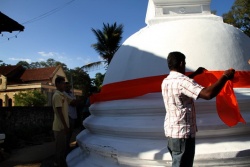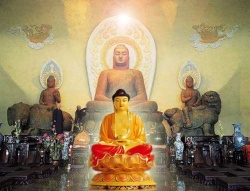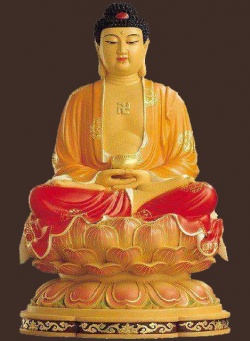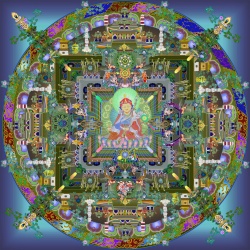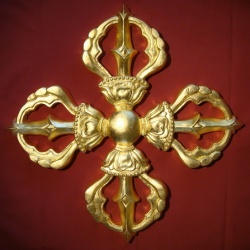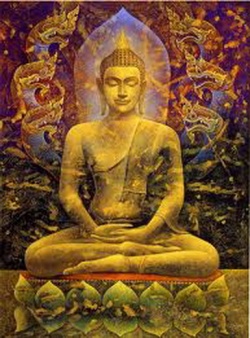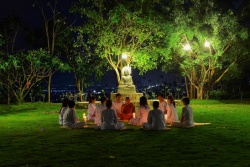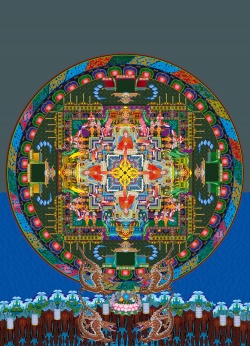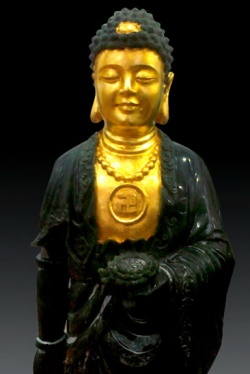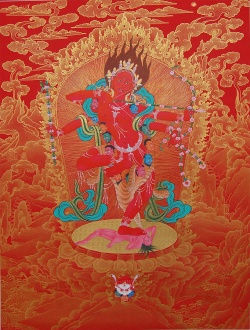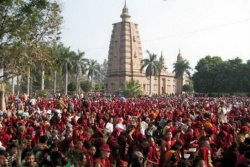Kūkai’s Poetry: The Coupling of the Exoteric and Esoteric
Kūkai’s Poetry:
The Coupling of the Exoteric and Esoteric
By Indrajala (Jeffrey Kotyk)
Kūkai or Kōbō Daishi 空海・弘法大師 (774–835) is one of Japan’s most famous intellectual figures. He not only founded the Shingon school of Buddhism (真言宗), which is one of esoteric Buddhism (密教), or more specifically yogatantra middle-period tantra (中期密教), but was also a prolific writer and artist. For the purposes of this article we will focus on Kūkai’s poetry. His works are interesting for a number of reasons. The first of which is that he was a Japanese aristocrat whose first language was not Chinese, yet he managed to master and become noted for his writings and poems in Chinese. He had received an education in the Chinese classics as was common for a male from his social class. Secondly, his skill at writing poetry itself was remarkable. Kūkai proficiently made use of a myriad of sources and classical allusions. Finally, the most remarkable feature of Kūkai’s work, and the main point of this article, is the coupling of the exoteric and the esoteric where the reader is given a fine poem which is pleasant enough on the surface, but almost always contains subtle meanings - one is challenged to pull back the surface meaning and delve deeper and deeper, never being completely certain that the full meaning has been ascertained.
The dichotomy of a surface meaning and a true meaning is a theme in Kūkai’s essays on esoteric subjects and metaphysics. For example in his text entitled Meaning of the Word Hūṃ 『吽字義』, he makes a clear distinction between what is the surface meaning and what is the true meaning:
- 「一吽字相義分二」
- “The word hūṃ is divided into the characteristic and the truth.”
Kūkai then explains the significance of understanding the word as well as the consequences of not comprehending it:
- 「一切世間但知如是字相。未曾解字義。是故爲生死人。如來如實知實義。所以號大覺。」[1] “Although people know the word’s characteristic, they have never ascertained the truth of the word. Thus they are beings in samsara. The tathāgata knows the true meaning and is thus named as enlightened.”
This division between nominal appearances and ultimate truth is also to be found within his literary works. If one properly ascertains the meaning of his words, one is able to see into a rich world not unlike that of a mandala where everything takes on a highly symbolic meaning which points to a great liberating truth. This will be explained in greater depth below. Now we will examine some of Kūkai’s early poetry. The following comes from the epitaph (碑) Kūkai wrote for his teacher Huì Guǒ 惠果 in Cháng’ān who died in 805. Unfortunately while the temple where this epitaph was recorded at was discovered in Xī’ān in 1964, the stone pillar itself seems to have been lost.[2] Kūkai was about thirty one years of age when he wrote this piece. We should note that Kūkai had only arrived in China the year before. He had the unusual fortune of being able to intensively study and receive transmission from one of the highest of monks in the entire Tang Empire. This work, being written in his younger years, would reflect not only his literary abilities at the time, but also the knowledge and insight he had acquired over the previous year. In it we find a skilful use of rhyming as well as a sincere eulogy to his departed teacher.
- 生也無邊 行願莫極
- 麗天臨水 分影萬億
- 爰有挺生 人形佛識
- 粃尼密藏 呑并餘力
- 修多與論 牢籠胸臆
- 四分秉法 三密加持
- 國師三代 萬類依之
- 下雨止雨 不日即時
- 所化縁盡 泊焉歸眞
- 惠炬已滅 法雷何春
- 梁木摧矣 痛哉苦哉
- 松檟封閉 何劫更開
- Sentient beings are without end.
- The vow to save them all is without limit.
- The sun and moon overlook waters while linked to heaven.
- Casting the reflection onto the innumerable.
- Here there was a marvellous birth.
- Buddha’s consciousness in human form.
- The Vinaya and secret teachings,
- Are consumed and assimilated with energy to spare.
- The sutras and commentaries are pulled into the chest and retained.
- The Dharma taken in the four divisions.
- The Three Secrets practised.
- The national teachers across three generations.
- The masses rely on them.
- It rains and they stop the rain, right then and there.
- When the causes and conditions for teaching expire,
- one quietly retires to the true world.[3]
- When the lamp of wisdom is already extinguished,
- at what spring shall the dharma strike?
- When the beams have collapsed, is that not bitter and painful?
- When the entryway to the tomb is sealed with pine and tea trees,[4]
- how many kalpas until it opens again?[5]
Kūkai begins this eulogy by summoning the spirit of the Mahāyāna which is most appropriate when honouring a deceased Buddhist master who certainly dedicated much of his life to learning, teaching and spreading the teachings for the sake of all sentient beings.
The lines about the sun and moon casting a reflection onto the innumerable is likely an allusion to the cosmic power of the dharmakāya which in the esoteric vision is the underlying force which gives rise to time and space for the good of all sentient beings. This will be described in detail below. What is important here is that Kūkai is essentially praising his teacher and equating him to a Buddha – saying he was the manifestation of the Buddha’s consciousness in human form. These are words of praise that are without peer in ordinary Buddhist terms.
He goes on to suggest that his teacher has assimilated and mastered the primary divisions of Buddhist doctrine with energy to spare, as if he had no limits and had an unlimited reservoir of stamina. He also makes a reference to the mystical abilities of starting and stopping rain which were often associated with esoteric masters. However, all good things come to an end and when the conditions expired for this great master to walk this earth he passed away and woe to those who are now no longer so readily able to be taught by such an excellent being. When the grave has been sealed how many more years, or lifetimes or kalpas, might one have to wait before encountering such a perfect master again? This is particularly important for the esoteric practitioners whose practice relied heavily on transmissions from the teacher to the student (伝授), meaning that certain practices cannot be accomplished in the absence of a teacher with specific empowerments. This no doubt amplifies the importance of having the foot of an accomplished to sit at and receive teachings and empowerments from.
Kūkai’s relationship to Huì Guǒ was also particularly significant in that at the age of sixty before meeting Kūkai, Huì Guǒ “was living on solely to transmit his whole teachings to Kūkai.”[6] Kūkai was later named eighth patriarch at the age of thirty-two. Indeed, for being able to receive such intensive training he was quite grateful and this eulogy conveys his emotions in exquisite poetry with subtle allusions to the esoteric.
The following is from a letter sent in response to a friend named Yoshimine No Yasuyo 良岑安世, a half-brother of Emperor Junna, who was made minister in 816 (弘仁七年). Kūkai died in 835 so we can assume that this poem was written around the last decade of his life and would represent his fully matured intellectual and literary talents.
- 「贈良相公詩」
- 孤雲无定處
- 本自愛高峯
- 不知人里日
- 觀月臥青松
- 忽然開玉振
- 寧異對顔容
- 宿霧隨吟斂
- 蘭情逐詠濃
- 傳燈君雅致
- 余誓濟愚庸
- 機水多塵濁
- 金波不易從
- 飛雷猶未動
- 蟄蚑匪開封
- 巻舒非一己
- 行藏任六龍
- A lone cloud has no place to settle.[7]
- From the beginning I cherished the high peaks;
- not knowing the secular life.[8]
- I watch the moon and lay in the green pines.
- Suddenly it opens and the jade within rings.[9]
- It’s no different than meeting face to face.
- The foggy mind fades with recitation. [10]
- A lovely sensation as I sing.
- Transmitting the lamp is your fine goal. [11]
- I as well have sworn to save the fools.
- If the waters are soiled with defilements,[12]
- following the golden waves is not easy.[13]
- When the lightening has yet to strike,
- the insects have not come out of their holes. [14]
- Shrinking and expanding is not to be decided on one’s own; [15]
- going out and seclusion is left to the Six Dragons.[16] [17]
The poem vividly illustrates Kūkai’s proficient use of intertexuality. He makes subtle references to classical sources including the Lǐjì 禮記, Huáinánzǐ 淮南子, Mèngzǐ 孟子 and the Yìjīng 易經, as well as pointing to a more esoteric Buddhist meaning that is not immediately visible on the surface of the poem. For the modern reader this is potentially quite difficult to grasp, but we need to keep in mind that in Kūkai’s time the literati, not only of China but also Japan, would have been familiar with the Chinese classics from a young age. The result is poetry rich in classical references and skillfully tailored to produce an intriguing thought provoking work. These references also present a challenge to the translator attempting to convey the same meaning in a modern western language while creating a comprehensible translation.
The first two lines of the poem reflect the last two. The lone cloud without a place to settle is Kūkai referring to himself, or more specifically to his lifestyle.[18] At the end the reader is prompted to consider that progress, that is to say movement and seclusion, is best left to the Six Dragons which is an allusion to a line in the Yìjīng where it is suggested that one should act according to circumstances as they arise. As one might clearly see the beginning foreshadows the end.
Kūkai does however present his own feelings which are not entirely given to aimlessness: “From the beginning I cherished the high peaks.” He cherishes the peaks, but is obliged to move when circumstances dictate such actions. Further into the text he addresses his friend and tells him that transmission of the dharma is not only his companion’s duty, but also his own. Hence, he is obliged to leave his lofty peaks reluctantly because of his vow to save the fools down below and hence the reason for the descent from much loved, presumably spiritual, heights. One might even sense a feeling of humility in that he is reluctantly descending in accordance not only with his vows, but because he wishes to emulate and follow his companion to whom he has written this poem.
Concerning the descent from the mountain, he might be referring to his love of Kōyasan 高野山, where he built the temple that he would later pass away at. In 818 he first climbed the mountain and it was in the following year that he officially consecrated the mountain. From thereon construction began. As Hakeda notes it is not clear how many times he climbed the mountain, but judging from the letters he sent during this period he went to the mountain whenever he could.[19] The cherishing of the peaks might reflect his desire to be at the site of his ongoing project rather than down below. In his later years he was still occasionally reluctantly drawn off the mountain when the state called on him to perform various functions. This is still a kind of “spiritual heights” in the sense that it is at Kōyasan and not the court in Kyōto where he can commit himself to rigorous spiritual practices and teaching uninterrupted the mysteries to his students. Alternatively, he might simply be referring to a kind of spiritual samādhi from which he must reluctantly leave to fulfil his vow and obligations towards those down below.
Lightening and thunder come from the clouds, and he is that force which prompts the insects in the ground to come out of their holes and awaken. He and his friend whom he has instructed to transmit the dharma are obliged to go down to the lowest places and save the unenlightened beings. However, this is only to be done when the waters, that is to say one’s own mind and spiritual resolve, are pure and when the time is right as the last two lines instruct.
Judging from the approximate date of the poem and the circumstances that he would have written it in, it seems possible that the cherishing of mountain peaks refers specifically to Kōyasan where at the time construction of his temple complex was in progress and required his attention while the court called on him for unrelated matters. The poem begins at the peaks of a mountain, moves down through the tree tops, into the waters and finally ends at the ground. It draws the reader through various natural scenes which are symbolic of the elements. One can easily enjoy the literary quality of this, but we need to be mindful of a more meaningful purpose. As Matsunaga explains for the esoteric practitioner the whole natural world becomes the setting, contents and final truth of a sutra – the Buddha’s body, speech and mind fill up empty space and nature itself is a manifestation of the supreme.[20] Being devoted to and knowledgeable about the esoteric, Kūkai perhaps painted the scene of the mountains, trees and waters with this unique vision of the world in mind. For him it is not merely the scriptures of the words of the historical Buddha that teach the dharma, but it is also the trees and moon that preach the liberating truth from a kind of great maṇdala (曼荼羅) that encompasses the entire physical world.
When we the readers consider this, the immensity and profound worldview that Kūkai presents us becomes clear. The natural world upon which he narrates his poem is the dharmakāya (法身). John Krummel explains the nature of the dharmakāya (hosshin 法身) in Shingon:
- Hosshin in Shingon thought is not an abstract truth transcending the mundane world. Rather all phenomena and thing-events of this cosmos, in their very transience, are each themselves embodiments of truth and the cosmos as a whole comprised of these impermanent and interdependent beings is eternally an embodiment of truth, the hosshin. Moreover this concrete cosmic identification between Buddha, truth, and the cosmos of thing-events, was “personal.” That is, hosshin was equated with the Buddha Dainichi. The cosmos as the manifestation of truth, the Dharma, was itself hence equated with the body of the personal Buddha Dainichi. And in turn, Dainichi with his cosmic body is then the embodied personification of the universal Buddha-nature inherent in all beings and the Dharma that is manifest everywhere.[21]
Zengyō Shimoizumi’s summary should also be noted as it highlights the idea that Dainichi Nyorai includes us human beings as well.[22]
As noted above this amplifies the meaning and significance of the scene Kūkai has summoned with his poetry – it is not merely mountains and trees, but Dainichi Nyorai (大日如来), the personified dharmakāya. The mountain peak is form, form is emptiness and emptiness is the dharmakāya. The reader, the writer and the very poetry itself is a teaching of Dainichi Nyorai. Here lay the more subtle esoteric meaning of the poem.
The following poem mixes both poetic qualities and metaphysical speculation. Here we are exposed to a mind contemplating the nature of perception and perceiver.
- 天雨濛濛天上來 水泡種種水中開
- 乍生乍滅不離水 求自求他自業裁
- 即心變化不思議 心佛作之莫怪猜
- 万法自心本一体 不知此義尤可哀
- They arise and then they cease; never leaving water.
- Seeking inward, seeking outward; one’s actions are determined.[23]
- Myriad phenomena arise from the mind; they are originally one body.
- Not understanding this truth is most pitiful.[25]
Much of Kūkai’s poetry contains the same characteristics as we find in the above poem. He readily utilizes natural scenery to paint a picture from which he preaches the dharma or conveys reflections on some gnosis or metaphysical insight. As one would expect from a priest his poetry is usually religious in orientation. However, as discussed above the religious content, or at least the majority of what is presented, is almost always tucked behind the natural scenery which acts as a kind of surface symbolism directing the reader to a deeper understanding. Symbolism as an optimal means to an end is a characteristic of esoteric Buddhism.
We should make a specific note that in this poem the first half is external observation and later half is internal speculation – a dichotomy of subject and object. Abe describes the myriad variety of bubbles as arising and ceasing according to causes and conditions yet still their origin and essence remains unchanged. He also suggests that this poem is about the many experienced illusions that arise and cease during meditation revealing that all the universe’s phenomena are to be found within the mind.[26] This is likely in reference to Yogācāra which was also concerned with a false subject-object duality. This poem sets up this very dichotomy. Here we have the observed raindrops and the observing mind which appear different, yet share the same common source or single body. The Yogācāra posited that the only real existent was the mind (唯識). The similarity here is no coincidence.
For Kūkai, however, the Yogācāra view is not the final truth, but merely a stage on the path towards the absolute. This leads one to wonder if the surface meaning of this poem is really the true meaning or not. Kūkai presented an outline of a ten stage path to enlightenment (十住心論) that basically categorizes the various major schools of Buddhist and non-Buddhist thought beginning with the unstable goatish mind (異性羝羊心) and ending with the secret sublime mind (秘密莊嚴心) which “breaks through its attachment to void and fully realizes its true nature. In this realm of affirmation, the individual experiences the externally self-existing enlightenment of the universal Buddha.”[27] Yogācāra on Kūkai’s graded list is only number six. This would indeed imply that this poem perhaps has a deeper meaning than what Abe describes. As Kūkai himself wrote: it would be a pity for us not to understand this truth. What is the hidden meaning in this poem?
First we must take note of the following:
- “The function of the hosshin is equated with all movements and change that occur in the cosmos. Such cosmic alterations are categorized in three ways in terms of visible form (e.g., loco-motion or change of place, and transformation or change in shape), the audible (sound), and the mental (the thinking process). Visible alterations are movements of Dainichi's body (shin 身), audible alterations are movements of Dainichi's speech (ku 口), and mental alterations are movements of Dainichi's thoughts (i 意). … Since the body of Dainichi is the cosmos itself, these “three mysteries” of its functions are at work in all thing-events and are ultimately non-dualistic with the corresponding movements of ourselves.”[28]
The perpetual flux of rain drops and the observer – or phenomena and mind, are indeed one, but what is this final one? As Krummel noted above alterations are movements of Dainichi’s body, speech and thoughts. To say phenomena and mind are one is not the final truth because the question of what is the one extends even further. In the case of this poem the surface characteristic is that of Yogācāra, but the true meaning is that of Dainichi. The pouring rains are alterations of Dainichi’s body while the cognition and contemplation are alterations of Dainichi’s thoughts. These functions are non-dualistic with the movements of both the reader and writer of the poem. This poem fulfils not only the truth of the Yogācāra, but also the more subtle truth of the esoteric.
The next poem illustrates Kūkai’s compassionate side, but gives rise to a question of whether the poem truly reveals his genuine thoughts or not.
- 昔日剃頭今長髪
- 出家二種心惟重
- 紅花緑實一株物
- 君見春秋顔色同
- 世理无常人如此
- 心縁不動大道通
- 長江萬里以相答
- 雖爾處身如虚空
- Long ago you received the tonsure; now your hair is long.
- Of these two forms of renunciation heart is important.
- Red flowers and green fruits are of the same trunk.
- You see that in spring and autumn their colours are the same.
- The principle of the world is impermanence; people are like this.
- If mental cognition stops moving the Great Way is ascertained.
- A long river may extend ten thousand miles, but the waters all pass together.
- Although this may be so, where the body abides is like empty space. [29]
Again here we find Kūkai utilizing natural scenery from which to express his thoughts. There are a few subtle features in this poem that should be discussed. Firstly, Kūkai is not laying down criticism against this long haired person in question. The Iwanami annotated version describes the two varieties of renunciation (出家二種) as the former being the appearance of renunciation and the latter being the actual practice of the buddhadharma. Concerning the second last line it is noted that although a long river and its waters may move in numerous directions, constantly changing in shape and form, it still flows together. Likewise the renunciate monk and the long haired practitioner may be of two different appearances, but their minds are the same. [30]
With these two points in mind, what this poem is discussing should become clear. Kūkai illustrates his point by speaking of entities existing in the natural world that appear to be different, yet still come from the same root. Red flowers and green fruits, for example, are nominally different objects, yet their source is the same tree. The flowers of spring and autumn arise to their greatest splendour at two different times of the year, yet they share the same colours. So, both the tonsured monk and the long haired former monk have different qualities, but their minds abide in the same place. Kūkai does not scold or criticize the former monk in any way, but rather generously supports him. For Kūkai appearances are secondary to the point of practicing the buddhadharma – if the mind should ascertain the Great Way, what matter whether the individual has hair or not? What matter the shape of rivers when they all flow to the same place? The principle of the world is impermanence, which is a constant flux of movement and change, yet he who has ceased moving has ascertained the Great Way. The superficially degenerate one has different appearances from the properly tonsured monk, yet the question one is made to ponder is whether surface appearances can truly reveal the quality of the individual in question.
The final line may be referring to a kind of “non-abiding” which is common in Mahayana Buddhism. Again, this is in praise to the long haired former monastic – for his place of abiding is not concerned with being tonsured or not, which is really of no importance if one realizes emptiness. In the absence of dualistic reifications, who is the proper and who is improper?
This poem perhaps also says something of Kūkai’s own personality because in this poem we find no harsh criticism or condemnation. Instead of criticizing the former monk or demanding that he return to a more orthodox appearance, he is generous and supportive. One account of Kūkai from his immediate disciple Shinzei was particularly positive:
- “When I visited him for the first time, I felt as if he had been very close to me for a long time. I served him as an attendant for years. Yet I have never seen him act without integrity.”[31]
However, there is one lingering question that arises when we consider how strict Kūkai was with obeying the precepts himself. He stressed that the precepts had to be followed if people were to stay with him.[32] This leads one to wonder if the feelings and thoughts presented in the poem were tailored for a particular individual in mind. It would seem that this long haired ascetic under examination was not his own student, so he probably did not feel compelled to demand reform and proper adherence to the precepts he laid out in his own community. Another possibility is that this individual in question is just a fictional character and not a real person.
Indeed Kūkai was by most standards an unusually successful and talented person in the history of Buddhism, Japanese history and in the world of Chinese poetry where he earned a name for himself. His poetry is a virtual storehouse of classical allusions, Buddhism, poetic style and his own gnosis – all of this is extremely valuable to the scholar seeking to understand him and the lineage he founded. His ability to weave esoteric Buddhist allusions within stable structures of exoteric truth is perhaps a skill unique only to him in this period. This is also perhaps his greatest appeal – that the reader is never left entirely at ease and satisfied that they have completely ascertained the complete meaning behind his poems which act as a kind of mandala illustrating the enlightened vision of the world from which true wisdom and compassion are gained. The unenlightened reader is essentially left on the edge of a hook without ever really knowing whether or not they have completely understood the subtle meanings which perhaps can drive one to explore the mysteries Kūkai urged us to examine.
Footnotes
- ↑ 大正新脩大藏經第七十七冊 No. 2430《吽字義》
- ↑ Nihon Koten Bungaku Taikei 71 Seireishū Sankyōshiki, 12th Edition, ed. Shōkō Watanabe and Yūshō Miyasaka (Tokyo: Iwanami Shoten, 1980), 197.
- ↑ This true world presumably being Nirvana from which they will emanate once more when the appropriate conditions arise.
- ↑ See Morohashi Daikanwa Jiten, No. 6, 580: 檟Jiǎ: 「茶の一種」; camellia sinensis.
- ↑ Chinese source text: Nihon Koten Bungaku Taikei 71 Seireishū Sankyōshiki, 12th Edition, ed. Shōkō Watanabe and Yūshō Miyasaka (Tokyo: Iwanami Shoten, 1980), 205.
- ↑ Yoshito Hakeda, Kūkai: Major Works (New York: Columbia University Press, 1972), 32.
- ↑ Kūkai is referring to himself. See Nihon Koten Bungaku Taikei 71 Seireishū Sankyōshiki, 12th Edition, ed. Shōkō Watanabe and Yūshō Miyasaka (Tokyo: Iwanami Shoten, 1980), 171.
- ↑ Ibid. 人里日: Secular life.
- ↑ 《孟子》(萬章下) 孟子曰:“伯夷,聖之清者也;伊尹,聖之任者也;柳下惠,聖之和者也;孔子,聖之時者也。孔子之謂集大成。集大成也者,金聲而玉振之也。金聲也者,始條理也;玉振之也者,終條理也。始條理者,智之事也;終條理者,聖之事也。智,譬則巧也;聖,譬則力也。由射於百步之外也,其至,爾力也;其中,非爾力也。
- ↑ 宿霧:A cloudy or foggy state of mind. See Nihon Koten Bungaku Taikei 71 Seireishū Sankyōshiki, 12th Edition, ed. Shōkō Watanabe and Yūshō Miyasaka (Tokyo: Iwanami Shoten, 1980), 171.
- ↑ Transmission of the Dharma. See Kōbōdaishi Kūkai Zenshū No. 6 (Tokyo: Chikuma Shobō, 1984), 187.
- ↑ Ibid. 機 refers to the possibility of invoking an interest in the dharma when meeting the opportunity to do so. 水 refers to religious inclinations.
- ↑ Ibid. 金波:metaphor for moonlight or the Buddhadharma.
- ↑ 《禮記》(月令) 是月也,日夜分。雷乃發聲,始電,蟄蟲咸動,啟戶始出。
- ↑ 《淮南子》(卷一原道訓) 與剛柔卷舒兮, 與陰陽俛仰兮。
- ↑ 《易經》(乾彖傳)大明始終,六位時成,時乘六龍以御天。
- ↑ Chinese source text: Nihon Koten Bungaku Taikei 71 Seireishū Sankyōshiki, 12th Edition, ed. Shōkō Watanabe and Yūshō Miyasaka (Tokyo: Iwanami Shoten, 1980), 171.
- ↑ Kōbōdaishi Kūkai Zenshū No. 6 (Tokyo: Chikuma Shobō, 1984), 187.
- ↑ Yoshito Hakeda, Kūkai: Major Works (New York: Columbia University Press, 1972), 48-49.
- ↑ Yūkei Matsunaga, Kūkai Hannyashinkyō no Himitsu wo Yomitoku (Tokyo: Shunjūsha, 2006), 21.
- ↑ John Krummel, "Kûkai", The Stanford Encyclopaedia of Philosophy (Fall 2008 Edition), Edward N. Zalta (ed.). http://plato.stanford.edu/archives/fall2008/entries/kukai/ (accessed March 16, 2009).
- ↑ 「私たちを含めた大自然、大宇宙そのものが大日如来の姿であり、木々をわたる風や星のきらめきなど、すべてのものが大日如来の神秘的な説法と考えるのです。」 Zengyō Shimoizumi, “Mikkyō Nitsuite,” Daihōrin, March 2009, 97.
- ↑ Abe translates this line differently: “自らの業によって生じまた滅す” See: Ryūjū Abe, Kūkai no Shi (Tokyo: Shunjūsha, 2004), 98.
- ↑ See 佛學小辭典, 183:【心佛】①依心成佛的意思。②是心是佛的意思。③心中所現之佛、叫做心佛。
- ↑ Chinese source text: Ryūjū Abe, Kūkai no Shi (Tokyo: Shunjūsha 春秋社, 2004), 97.
- ↑ Ibid., 99.
- ↑ Taikō Yamasaki, Shingon Japanese Esoteric Buddhism, trans. Richard and Cynthia Peterson (Boston: Shambala, 1988), 96.
- ↑ John Krummel, "Kûkai", The Stanford Encyclopedia of Philosophy (Fall 2008 Edition), Edward N. Zalta (ed.). http://plato.stanford.edu/archives/fall2008/entries/kukai/ (accessed March 16, 2009).
- ↑ Chinese source text: Nihon Koten Bungaku Taikei 71 Seireishū Sankyōshiki, 12th Edition, ed. Shōkō Watanabe and Yūshō Miyasaka (Tokyo: Iwanami Shoten, 1980), 451.
- ↑ Ibid., 451.
- ↑ Yoshito Hakeda, Kūkai: Major Works (New York: Columbia University Press, 1972), 95.
- ↑ Ibid., 94
Bibliography
- Abe, Ryūjū 阿部龍樹. Kūkai no Shi 『空海の詩』. 2nd Ed. Tokyo: Shunjūsha 春秋社, 2004.
- Hakeda, Yoshito. Kūkai: Major Works. New York: Columbia University Press, 1972.
- Kōbōdaishi Kūkai Zenshū No. 6 『弘法大師空海全集第六巻』. Tokyo: Chikuma Shobō筑摩書房, 1984.
- Krummel, John, "Kûkai", The Stanford Encyclopaedia of Philosophy (Fall 2008 Edition), Edward N. Zalta (ed.).http://plato.stanford.edu/archives/fall2008/entries/kukai/ (accessed March 16, 2009).
- Matsunaga, Yūkei 松長有慶. Kūkai Hannyashinkyō no Himitsu wo Yomitoku『空海 般 若心経の秘密を読み解く』.Tokyo: Shunjūsha 春秋社, 2006.
- Nihon Koten Bungaku Taikei 71 Seireishū Sankyōshiki『日本古典文学大系71三教指 帰 性霊集』. 12th Edition. Edited by Shōkō Watanabe 渡辺照宏 and Yūshō Miyasaka宮坂雄勝. Tokyo: Iwanami Shoten 岩波書店, 1980.
- Shimoizumi Zengyō 下泉全暁. “Mikkyō Nitsuite 密教について,” Daihōrin 大法 輪, March 2009, 97-101.
- Yamasaki, Taikō. Shingon Japanese Esoteric Buddhism. Translated by Richard and Cynthia Peterson. Boston: Shambala, 1988.
